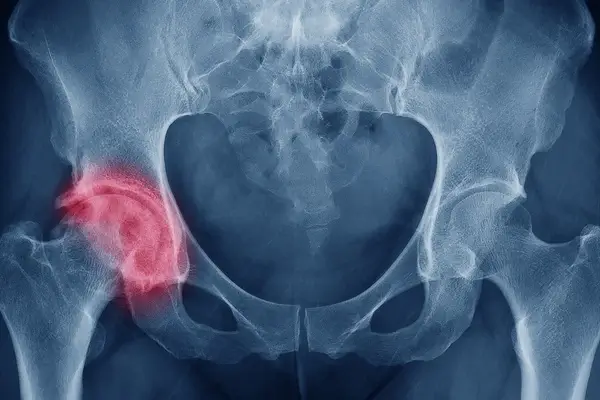Estimated reading time: 5 minutes
You might think the symptoms of a worn out hip joint include aches, pains, and even creaks from the hip itself. However, as we’re about to find out, this may not be the case. Join us as we explore the symptoms and solutions of a worn hip.

Private hip replacement at a glance
- Waiting time: 4-6 weeks
- Cost: £12,549
- Ways to pay: self-pay, insured, payment plans
- Procedure time: 1-2 hours
On this page:
A worn hip joint typically causes persistent pain in the groin and buttock, stiffness, and a reduced range of motion. A hip replacement may be recommended by a consultant when more conservative treatments like painkillers and physiotherapy fail are no longer effective.
What is a worn out hip joint?
A worn hip joint is typically when the cartilage and soft tissue around the hip socket breaks down. This can cause pain, discomfort, and inflammation in various different areas, from the knee to the pelvic bone.
What causes your hip joint to wear?
There are a number of factors that can cause a hip joint to wear. One of the most common of these is hip osteoarthritis (the most common form of hip arthritis). The causes of this condition are not fully known but contributing factors include obesity, hip trauma and a family medical history of hip issues.
Among the other factors to take into account are sports injuries (usually from high-impact sports) and other types of arthritis. These include rheumatoid and psoriatic arthritis.
Pain in your hip?
If you’re experiencing hip pain, try our hip suitability quiz. It will give you an idea of whether you’d benefit from booking a consultation with one of our hip specialists.
What are the symptoms of a worn out hip joint?
The following are common symptoms and signs of a worn hip joint:
- Hip pain – this is localised in the buttock and groin. You may feel pain in the thigh and down towards the knee. It may initially be present when you put weight on the leg or while walking
- Hip stiffness – it may be difficult to bend over or move the leg of your affected hip
- Loss of mobility and motion – you may experience a decreased range of motion when bending and stretching the leg
- Limp – due to pain while walking, you may eventually develop a visible limp and require an assistive device. Unfortunately, this may restrict your ability to carry out everyday activities.
How do you know if your hip is deteriorating?
It’s likely the pain and discomfort you experience will feel stronger and last for longer. It may also become less responsive to painkillers and physiotherapy.
If you’re experiencing any of the symptoms highlighted above, then you may have a deteriorating hip joint. You should contact your GP as soon as possible. Alternatively, you can book a consultation with a Practice Plus Group hip specialist.
What does a hip feel like when it needs to be replaced?
A hip that has deteriorated to the point where a replacement is recommended will likely be causing a lot of pain and discomfort, even while resting. The pain itself may feel dull and throbbing or sharp stabbing depending on the type of hip issue you have and what’s causing it.
Where is the pain from a worn hip joint?
The majority of hip pain is felt in or around the hip joint or in the buttock or groin. However, some people report discomfort in other areas of the body. These include the:
- knee
- thigh
- back.
How do I know if my hip pain is serious?
You should contact your GP or book a consultation if you are experiencing the following:
- sharp, acute pain in your hip caused by a heavy fall or injury
- visible changes to your hip or leg such as heavy bruising or bleeding
- inability to move or bear weight on your leg
- prolonged hip pain that has worsened over time
- ineffectiveness of conservative treatments such as pain relief.
Patient testimonial
“I had been quite sure my knee was the issue but my consultant did thorough tests and even offered me a steroid injection to show it was the hip.”
“I decided to take his advice that a hip replacement was the answer and we booked the surgery.”
Mike Rajkovic, hip surgery patient, Practice Plus Group Hospital, Barlborough
Solutions for a worn out hip
Initially, your GP or a consultant may recommend conservative methods to treat hip pain. These may range from over-the-counter pain relief to physiotherapy exercises. If these prove ineffective, the next stage may be a hip replacement. If this has been recommended to you, be sure to ask your doctor any questions you may have about hip surgery
Worn hip joint pain relief
At first, your doctor may recommend a course of pain medication to help manage your hip discomfort. These will likely be prescribed painkillers that are available over-the-counter at a pharmacy.
Exercises and physiotherapy
Alongside pain medication, your doctor may also suggest a course of physiotherapy to help manage your hip pain. You should make every effort to attend your classes and do the exercises set out for you.
Hip injections and medication
If physio and pain relief prove ineffective, the next step may be injections. If necessary, your doctor will be able to recommend steroid injections. These can be painful as they’re injected directly into the joint. They are anti-inflammatory and are designed to treat painful, swollen joints.
Hip replacement surgery
If all else proves ineffective or fails, your doctor may recommend surgery. Although a daunting prospect, total hip replacement surgery is an extremely common procedure which replaces the original joint with an artificial hip. From booking your hip surgery to the benefits and risks of the operation, Practice Plus Group has got you covered.







